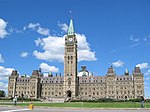Connaught Building
Designated heritage properties in OttawaFederal government buildings in OttawaGothic Revival architecture in OttawaOffice buildings in CanadaSussex Drive

The Connaught Building is a historic office building in Ottawa, Ontario, Canada, owned by Public Services and Procurement Canada. It is located at 555 MacKenzie Avenue, just south of the American Embassy. To the east, the building looks out on the Byward Market, and to the west is MacKenzie Avenue and Major's Hill Park. Today, it houses a portion of Headquarters operations for the Canada Revenue Agency (CRA). The Minister and Commissioner of the CRA have offices in the building.
Excerpt from the Wikipedia article Connaught Building (License: CC BY-SA 3.0, Authors, Images).Connaught Building
Rue Principale, Molsheim
Geographical coordinates (GPS) Address Nearby Places Show on map
Geographical coordinates (GPS)
| Latitude | Longitude |
|---|---|
| N 45.426388888889 ° | E -75.694722222222 ° |
Address
Rue Principale 63
67870 Molsheim
Grand Est, Frankreich
Open on Google Maps







